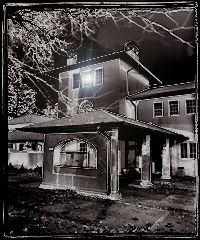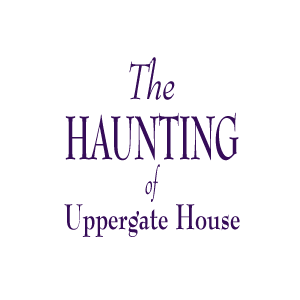|
|
||||||||||
|
Volume
75 Enigma: The Haunting of Uppergate House Wonderful
Woodruffs
When Wilhoit rounded a corner in the hallway, he bumped into the shape of a woman, silhouetted against the light of an exit sign.“When I bumped into her,” he says, “my knees just went to jelly.”
“I went off on my own at one point,” Robert Lo ’98C recalls, “and, as clearly as I’m talking to you right now, I heard a woman singing. I’m not saying it was a ghost, but it was something.”
|
BY RICHARD HERMES ’98C LATE AT NIGHT, THE HOUSE AT THE CORNER of Ridgewood and Uppergate drives seems to give off its own light. A white luminescence emanates from the interior and sets the building apart from the other nearby structures—a parking deck, the Emory Clinic—that have encroached since the house stood alone on the estate of Arthur Tufts. Tufts, the original contractor for Emory’s Atlanta campus, built the house in 1916 as his private residence while he carved out the University’s new home. The Tufts House, or Uppergate House as it is now known, is the oldest building on campus. Set on twenty-five acres of land acquired from Asa Griggs Candler, the house originally operated like a farm; crops and livestock were raised on the property for household use. Like other campus buildings, the three-story Italianate mansion had terra-cotta tile roofing, since replaced with asphalt shingles; its original pale pink stucco has been repainted white. Family and guests entered the first floor through a porte-cochere. Above the second-floor bedrooms was a tower, where, according to his obituary, Tufts died of influenza at the age of forty. From 1965 to 1994, the Information Technology Division used Uppergate House as offices, with a workshop in the basement and a mainframe computer room on the ground floor. On a cold evening in 1971, Mike Wilhoit, then director of the division, encountered something that scared him so thoroughly he never worked alone at night in the house again. Wilhoit had been in the basement, wiring a circuit for an old Teletype machine. Between nine and ten o’clock he came upstairs, unlocking two doors on his way to the main computer room. “We kept all of the doors locked up,” he says. “There is no way that anyone–or anything–should have been in that house.” But when Wilhoit rounded a corner in the hallway, he bumped into the shape of a woman, silhouetted against the light of an exit sign. “She was about this high,” he says, measuring up to his neck, about five feet, four inches, “and had a scarf on. When I bumped into her, my knees just went to jelly. She asked me, calmly, if her son was there. And I have no earthly idea . . . I was absolutely shaken when I bumped into her, and I have no idea how she got there.” A
couple of years later, Wilhoit overheard some “old-timers” Wilhoit never saw the ghost again, but in 1998 Robert Lo ’98C took an interest in the story. A creative writing major and aspiring filmmaker, Lo received permission from the Office of Campus Planning—which then occupied Uppergate House—to spend the night. He brought his video camera and two friends who considered themselves attuned to paranormal activity but were unaware of why Lo had brought them there. “I went off on my own at one point,” Lo recalls, “and, as clearly as I’m talking to you right now, I heard a woman singing. I’m not saying it was a ghost, but it was something.” When he returned, the others had not heard a thing, but earlier, they said, they had “felt” something. After investigating the place, Lo’s friends encountered two “hot spots”—specific areas of paranormal activity. One was a four-square-foot area in the exact location where Wilhoit described his encounter. The other was at the bottom of the winding stairway. While it is not hard to believe that someone could have fallen down those front stairs—they are remarkably steep and narrow for a residence of that size—the “old-timers’ ” claims could not be substantiated. However, considering the number of different groups that have lived or worked in the house over the years, the memory of such an accident could have easily faded to the realm of legend. The November 1943 issue of the Emory Alumnus reports that “the Tufts property, including the large home located just across the street from the Hospital, has been purchased by the University. The home will be remodeled and used as a dormitory for student nurses.” Could the apparition be the spirit of some deceased student nurse? Wilhoit said the silhouette had a scarf over her head. An investigation of an early 1940s Emory yearbook reveals that nurses during that time did wear headpieces to identify themselves, though they appear to be more like bonnets than scarves. And what of the woman’s question, “Have you seen my son?” Neither Wilhoit nor Lo knew this, but Arthur Tufts’ mother, like Tufts himself, died young. She passed away when he was a small boy. Within a year, the Uppergate House will be gutted, and the Department of Psychiatry will move in. Until then, it sits empty. The most recent occupants, the biomedical media department, were instructed by the fire marshal not to stay late in the evenings or on weekends, and to get out as soon as possible. The wiring, he said, is hazardous.
|
||||||||


